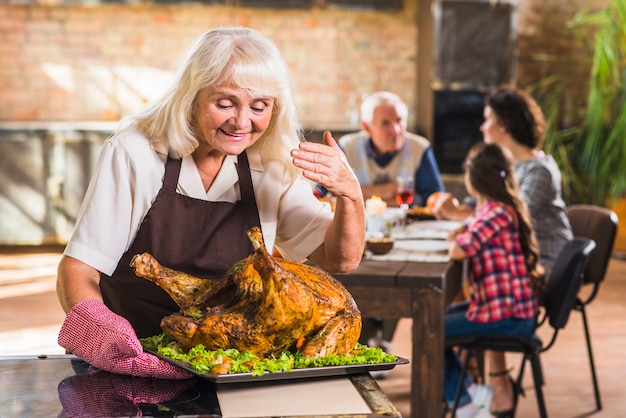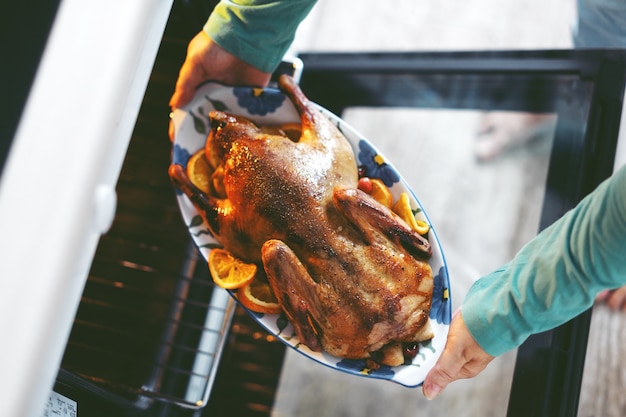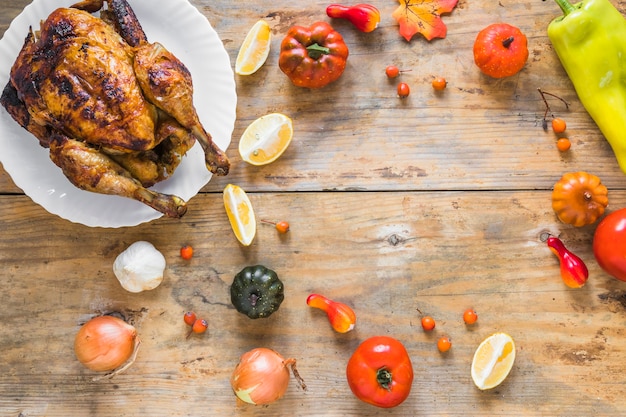Let’s face it, grilling chicken thighs is a rite of passage for any barbecue enthusiast. There's a certain magic to the smoky, chargrilled flavour that elevates this humble ingredient to new heights. But achieving that perfect balance of juicy, tender chicken and a crispy, golden-brown skin is no mean feat. It's all about timing, you see. And that's where this comprehensive guide comes in.
I've spent years in the kitchen, experimenting with different grilling techniques, learning from my own (and others') mistakes, and, of course, reveling in the triumphs of a perfectly grilled chicken thigh. This guide is a culmination of everything I've discovered, offering a foolproof roadmap to juicy, succulent perfection. So grab a cold beverage, settle in, and get ready to elevate your grilling game.
(Part 1) The Right chicken thighs: A Starting Point for Success

Just like any good recipe, it all begins with the right ingredients. Choosing the right chicken thighs is crucial, and trust me, it's not as straightforward as you might think. I've made my fair share of mistakes, buying those thin, bony thighs that end up dry and tough. Learn from my errors and consider these factors:
1. Skin-On or Skin-Off: A Matter of Preference and Purpose
The choice between skin-on and skin-off chicken thighs is a personal one, often influenced by your desired outcome. Some prefer the added flavour and moisture that skin provides, while others find it unnecessary. I tend to go for skin-on thighs as the fat renders during cooking, creating a juicy and flavorful chicken, and that crispy skin is just irresistible. The rendered fat adds a richness that’s hard to replicate. However, if you're aiming for a lighter meal, skin-off thighs are a good option. Just remember to keep an eye on them to avoid drying out.
2. Bone-In or Boneless: A Question of Convenience and Flavour
Boneless, skinless chicken thighs offer convenience, especially for those who prefer to avoid the hassle of removing bones. They’re also great for meal prepping, as you can easily portion them for individual servings. However, I find that bone-in thighs retain more moisture and offer a richer flavour. Plus, they tend to be a bit cheaper. It's really down to your preference and how much time you have for prepping. If you're short on time, boneless, skinless thighs are a good choice. If you're looking for the best flavour, bone-in is the way to go.
3. Thick and Meaty: A Guarantee of Tenderness and Even Cooking
Look for chicken thighs with a good amount of thickness and meat. These thighs will cook more evenly and have a better chance of remaining juicy and tender. Think of it like this: thicker thighs mean more surface area to absorb the heat, allowing the juices to stay locked in, resulting in that melt-in-your-mouth texture. I always try to find thighs that are at least 1.5 inches thick. Thinner thighs might cook too quickly, leading to dryness. Avoid any thighs that look thin or have a lot of gristle.
(Part 2) Prepping the Chicken: Unveiling the Secret to Tenderness

Once you've chosen your perfect chicken thighs, the next step is prepping them for grilling. This may seem like a simple step, but it's a crucial one, as it lays the groundwork for that perfect outcome. It's all about maximizing flavour and ensuring that your chicken cooks evenly.
1. Patting Dry: The Key to Crispy Skin and Even Cooking
You might be tempted to skip this step, but patting your chicken thighs dry with paper towels is essential for achieving crispy skin. Excess moisture prevents the skin from browning and crisping up, resulting in a soggy, disappointing result. Not only that, but excess moisture can create steam on the grill, hindering the cooking process and resulting in uneven cooking. So take the time to thoroughly pat those thighs dry before you start grilling.
2. Salt and Pepper: The Simplest Seasoning for the Best Flavour
I'm a firm believer in keeping things simple when it comes to seasoning. A generous pinch of salt and freshly ground black pepper is all you need to enhance the natural flavour of the chicken. Don't be afraid to season generously. Salt helps to draw out moisture, resulting in a more tender and juicy chicken. Pepper adds a bit of heat and depth of flavour.
3. Optional Extras: Adding Your Own Personal Touch
While salt and pepper are the essentials, feel free to experiment with other seasonings to add your own personal touch. I sometimes like to add a sprinkle of paprika, garlic powder, or onion powder to my chicken. You can also use a dry rub, which is a blend of spices that you apply to the chicken before grilling. But remember, less is more. Too many spices can overpower the delicate flavour of the chicken.
(Part 3) The Power of Marinades: Tenderness and Flavour Booster

Marinades can add a whole new dimension of flavour to your grilled chicken thighs. They also help to tenderize the meat, ensuring juicy and succulent results. I’ve learned through experimentation that marinating overnight is ideal for letting those flavours penetrate deeply.
1. Simple Marinades: Easy to Make, Delicious Results
You don't need complicated, fancy ingredients to create a delicious marinade. Some of my favourite simple marinades include:
- Lemon-Herb Marinade: The acidity of lemon juice helps to tenderize the chicken, while fresh herbs like rosemary, thyme, and oregano add a burst of flavour.
- Soy Sauce-Ginger Marinade: This marinade is a classic for a reason. The combination of soy sauce, ginger, and garlic creates a savory and slightly sweet flavour that complements the chicken perfectly.
- Honey-Mustard Marinade: For a slightly sweeter marinade, try honey-mustard. The sweetness of the honey balances the tanginess of the mustard, creating a delightful flavour profile.
2. Using a Ziplock Bag: Easy Marinating and Storage
A simple and effective way to marinate chicken thighs is to use a ziplock bag. Add the chicken thighs and marinade to the bag, seal it tightly, and refrigerate for at least 2 hours, or ideally overnight. The bag allows the marinade to evenly coat the chicken and prevents any spills.
3. Removing Excess Marinade: Ensuring Crispy Skin
When you’re ready to grill, remove the chicken thighs from the marinade and pat them dry with paper towels. This step is crucial for achieving crispy skin. The excess marinade will steam the chicken rather than allow the skin to crisp up.
(Part 4) Selecting the Right Grill: A Foundation for Success
The type of grill you choose can greatly impact the results of your grilled chicken thighs. There are many different types of grills available, each with its own pros and cons. I've had the opportunity to work with different types of grills, and I've learned to appreciate the unique characteristics of each one. Choosing the right grill depends on your desired cooking style and the overall experience you're aiming for.
1. Gas Grills: Quick and Easy for Everyday Use
Gas grills are a popular choice for their convenience and ease of use. They heat up quickly and offer consistent temperatures, making them ideal for everyday grilling. I love gas grills for their ability to sear chicken thighs quickly, resulting in a nice char. Gas grills are also great for those who are new to grilling, as they offer more control over the heat.
2. charcoal grills: The Authentic Barbecue Experience
Charcoal grills are known for imparting a smoky, authentic barbecue flavour to the food. They require a bit more time and effort to get started, but the results are worth it. I use charcoal grills for those special occasions where I want to create a truly smoky taste. Charcoal grills also offer a more traditional grilling experience, and many people find the process to be more enjoyable.
3. pellet grills: Precision and Convenience Combined
Pellet grills are becoming increasingly popular thanks to their combination of precision temperature control and wood-fired flavour. They offer a more consistent and controlled cooking experience than charcoal grills, making them great for those who want to achieve perfect results every time. I’ve recently purchased a pellet grill and I can’t wait to experiment with different wood pellets and see how they affect the flavour of my chicken. Pellet grills are also ideal for smoking meats, as they can maintain a low and slow temperature for extended periods.
(Part 5) Setting the Grill: Mastering the Temperature
The temperature at which you grill your chicken thighs is crucial for achieving the perfect balance of tenderness and crispiness. I’ve learned that a medium-high heat is ideal for searing the chicken and creating that delicious char.
1. Medium-High Heat: The Ideal Temperature
For a gas grill, aim for a temperature of around 400°F (200°C). For a charcoal grill, you'll want to have a bed of hot coals, and for a pellet grill, set the temperature to about 400°F (200°C). I’ve found that this temperature allows the chicken to cook quickly without drying out.
2. Preheating the Grill: A Must for Even Cooking
Preheating the grill before adding the chicken thighs is essential for ensuring even cooking. Allow the grill to heat up for 10-15 minutes. You can check if it's ready by holding your hand a few inches above the grates. If it's too hot to hold your hand there for more than a few seconds, then your grill is ready.
(Part 6) Grilling the Chicken: Timing is Everything
Now comes the moment of truth. You’ve prepped the chicken, chosen the right grill, and set the temperature. Now it’s time to grill those chicken thighs to perfection.
1. Oil the Grates: Preventing Sticking and Ensuring Even Cooking
Before placing the chicken thighs on the grill, brush the grates with a little oil. This will prevent the chicken from sticking and ensure that it cooks evenly. You can use any type of cooking oil, but I prefer olive oil for its flavour. This step is especially important when grilling chicken with skin-on, as it helps to prevent the skin from sticking to the grates.
2. Placing the Chicken: Ensuring Even Cooking
Place the chicken thighs on the grill, ensuring that they are spaced evenly apart. Don’t overcrowd the grill, as this will cause the chicken to steam rather than grill. Spacing the chicken out will allow heat to circulate evenly, resulting in a more evenly cooked chicken.
3. cooking time: A Guide for Different Thigh Sizes
The cooking time for chicken thighs will vary depending on their size and thickness. Here’s a general guide for different sizes of thighs:
| Thigh Size | Cooking Time |
|---|---|
| Small (1-1.5 inches thick) | 10-15 minutes per side |
| Medium (1.5-2 inches thick) | 15-20 minutes per side |
| Large (2 inches thick) | 20-25 minutes per side |
It's important to note that these are just general guidelines. The actual cooking time may vary depending on your grill, the heat of the coals, and the thickness of the chicken.
4. Don’t Overcook: Ensuring Juicy and Tender Chicken
It's essential not to overcook chicken thighs. Overcooked chicken will be dry and tough. I’ve found that it’s best to use a meat thermometer to check the internal temperature. The chicken is done when it reaches an internal temperature of 165°F (74°C). Don’t worry about poking holes in the chicken with the thermometer, as it won’t affect the cooking process significantly.
(Part 7) Resting the Chicken: Bringing Out the Juices
After you remove the chicken thighs from the grill, let them rest for 5-10 minutes before slicing and serving. This step allows the juices to redistribute throughout the meat, resulting in a more tender and juicy chicken. I’ve learned to always rest my chicken for at least 5 minutes, and sometimes longer, depending on the size of the chicken.
(Part 8) Serving the Chicken: A Culinary Delight
Now it’s time to enjoy the fruits of your labour. Serve your perfectly grilled chicken thighs with your favourite sides and enjoy a delicious and satisfying meal.
1. Delicious Sides: Complementing the Flavour
Grilled chicken thighs pair well with a variety of sides, such as:
- grilled vegetables: corn on the cob, zucchini, peppers, and onions are all delicious grilled and complement the chicken perfectly. They add a touch of freshness and sweetness to the meal.
- potato salad: A classic side for grilled chicken, potato salad is creamy and refreshing. It adds a touch of comfort food to the meal.
- Coleslaw: For a lighter side, try coleslaw, which adds a crunchy and tangy contrast to the chicken. It balances the richness of the chicken and adds a burst of flavour.
- Rice: A simple and versatile side, rice goes well with any type of grilled chicken. It’s a great way to soak up any extra juices from the chicken and create a hearty and satisfying meal.
2. Sauces: Enhancing the Flavour
While grilled chicken thighs are delicious on their own, a drizzle of sauce can take them to the next level. Some delicious sauces to try include:
- bbq sauce: A classic choice for grilled chicken, BBQ sauce adds a smoky, sweet and tangy flavour. It’s a great way to add a touch of indulgence to the meal.
- Honey-Mustard Sauce: A sweet and tangy sauce that complements the chicken beautifully. It adds a touch of sweetness and a hint of tanginess to the meal.
- Garlic Herb Sauce: A simple and flavorful sauce that enhances the natural flavour of the chicken. It’s a great way to add a touch of freshness and flavour to the meal.
FAQs
- What temperature should I grill chicken thighs at? A medium-high heat of around 400°F (200°C) is ideal for grilling chicken thighs. This temperature allows the chicken to cook quickly without drying out.
- How long should I grill chicken thighs? The cooking time will vary depending on the size and thickness of the chicken thighs. However, as a general rule, small chicken thighs (1-1.5 inches thick) will cook for 10-15 minutes per side, medium chicken thighs (1.5-2 inches thick) will cook for 15-20 minutes per side, and large chicken thighs (2 inches thick) will cook for 20-25 minutes per side.
- How can I tell if my chicken thighs are done? Use a meat thermometer to check the internal temperature of the chicken. The chicken is done when it reaches an internal temperature of 165°F (74°C).
- What happens if I overcook chicken thighs? Overcooked chicken thighs will be dry and tough. It’s best to err on the side of undercooking rather than overcooking, as you can always cook the chicken for a few more minutes if needed.
- What are some tips for grilling chicken thighs on a charcoal grill? When grilling chicken thighs on a charcoal grill, it's important to ensure that the coals are hot and evenly distributed. You can also use wood chips to add a smoky flavour to the chicken.
There you have it! Grilling chicken thighs to perfection is all about timing. With these tips and tricks, you’ll be able to impress your friends and family with juicy, tender chicken every time. So fire up the grill and get ready to enjoy a delicious and satisfying meal.
Everyone is watching

Prime Rib Roast Cooking Time Chart: Per Pound Guide
Cooking TipsPrime rib roast. Just the name conjures images of lavish dinners, crackling fires, and hearty laughter. It’s ...

How Long to Bake Potatoes in the Oven (Perfect Every Time)
Cooking TipsBaked potatoes are a staple in my kitchen. They're incredibly versatile, delicious, and surprisingly easy to m...

Perfect Rice Every Time: The Ultimate Guide to Cooking Rice
Cooking TipsAs a self-proclaimed foodie, I've always been a bit obsessed with rice. It's the foundation of countless cuisi...

The Ultimate Guide to Cooking Asparagus: Tips, Techniques, and Recipes
Cooking TipsAsparagus. The mere mention of this spring delicacy conjures up images of vibrant green spears, crisp and burs...

Ultimate Guide to Cooking the Perfect Thanksgiving Turkey
Cooking TipsThanksgiving. Just the word conjures up images of overflowing tables laden with delicious food, the scent of r...
